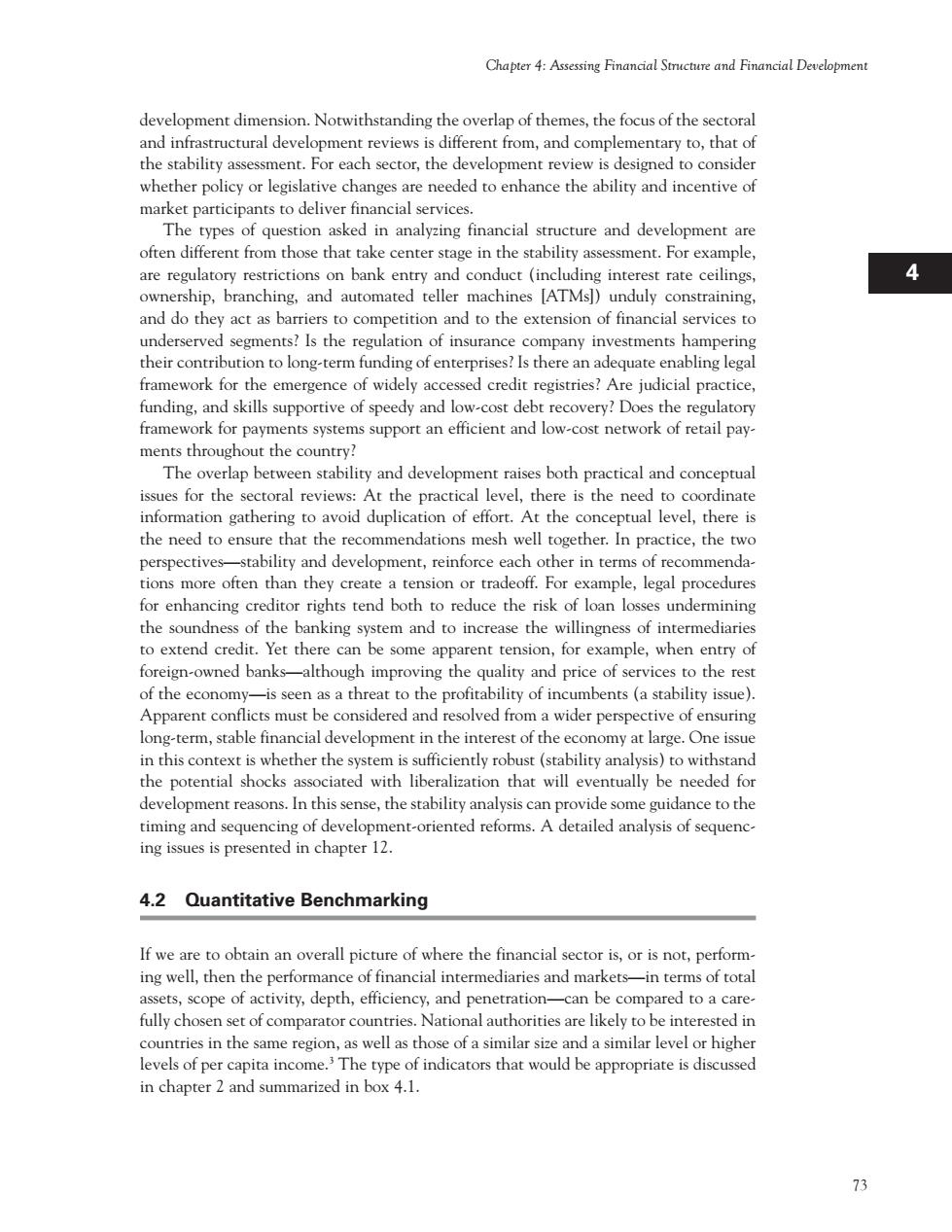正在加载图片...

Chapter 4:Assessing Financial and Financial Development development dimension.Notwithstanding the overlap of themes,the focus of the sectora and infrastructural development reviews is different from,and complementary to,that of the stability assessment.For each sector,the development review is designed to consider whether policy or legislative changes are needed to enhance the ability and incentive of market participants to deliver financial services. The types of question asked in analyzing financial structure and development are often differ ent from those that take center stage in the stability assessment.For example are regulato n hank e conduct (includir g intere 4 ch ing and automate chi nduly and do they act as barriers to competition and to the extension of financia services to underserved segments?Is the regulation of insurance company investments hampering their contribution to long-term funding of enterprises!Is there an adequate enabling lega framework for the emergence of widely accessed credit registries?Are judicial practice funding,and skills supportive of speedy and low-cost debt recovery?Does the regulatory framework for payments systems support an efficient and low-cost network of retail pay ments throughout the country? rlap betweer stability and develo ment raises both ractical and conce toral reviews the e is the need ina ormation gatheri here i the need to ensure that the recommendations mesh well together.In practice,the two perspectives- stability and development,reinforce each other in terms of recommenda- tions more often than they create a tension or tradeoff.For example,legal procedures for enhancing creditor rights tend both to reduce the risk of loan losses undermining the soundness of the banking system and to increase the willingness of intermediaries to extend credit.Yet there can be some apparent tension,for example,when entry of rowned banks though improv quality and price of services to the rest e econom y nts (a s Apparent cor mus sidered an esolved from der perspective of ensuring ong-term,stable financial development in the interest of the economy at large.One issu in this context is whether the system is sufficiently robust(stability analysis)to withstand the potential shocks associated with liberalization that will eventually be needed for development reasons.In this sense,the stability analysis can provide some guidance to the timing and sequencing of development-oriented reforms.A detailed analysis of sequenc. ing issues is presented in chapter 12. 4.2 Quantitative Benchmarking If we are to obtain an overall picture of where the financial sector is,or is not,perform ing well,then th inancial intermediaries and mark ets scope of a can b fullyhnof compro National authorities are likely to be interested in countries in the same region,as well as those of a similar size and a similar level or higher levels of per capita income.The type of indicators that would be appropriate is discussed in chapter 2 and summarized in box 4.1.73 Chapter 4: Assessing Financial Structure and Financial Development 1 I H G F E D C B A 12 11 10 9 8 7 6 5 4 3 2 development dimension. Notwithstanding the overlap of themes, the focus of the sectoral and infrastructural development reviews is different from, and complementary to, that of the stability assessment. For each sector, the development review is designed to consider whether policy or legislative changes are needed to enhance the ability and incentive of market participants to deliver financial services. The types of question asked in analyzing financial structure and development are often different from those that take center stage in the stability assessment. For example, are regulatory restrictions on bank entry and conduct (including interest rate ceilings, ownership, branching, and automated teller machines [ATMs]) unduly constraining, and do they act as barriers to competition and to the extension of financial services to underserved segments? Is the regulation of insurance company investments hampering their contribution to long-term funding of enterprises? Is there an adequate enabling legal framework for the emergence of widely accessed credit registries? Are judicial practice, funding, and skills supportive of speedy and low-cost debt recovery? Does the regulatory framework for payments systems support an efficient and low-cost network of retail payments throughout the country? The overlap between stability and development raises both practical and conceptual issues for the sectoral reviews: At the practical level, there is the need to coordinate information gathering to avoid duplication of effort. At the conceptual level, there is the need to ensure that the recommendations mesh well together. In practice, the two perspectives—stability and development, reinforce each other in terms of recommendations more often than they create a tension or tradeoff. For example, legal procedures for enhancing creditor rights tend both to reduce the risk of loan losses undermining the soundness of the banking system and to increase the willingness of intermediaries to extend credit. Yet there can be some apparent tension, for example, when entry of foreign-owned banks—although improving the quality and price of services to the rest of the economy—is seen as a threat to the profitability of incumbents (a stability issue). Apparent conflicts must be considered and resolved from a wider perspective of ensuring long-term, stable financial development in the interest of the economy at large. One issue in this context is whether the system is sufficiently robust (stability analysis) to withstand the potential shocks associated with liberalization that will eventually be needed for development reasons. In this sense, the stability analysis can provide some guidance to the timing and sequencing of development-oriented reforms. A detailed analysis of sequencing issues is presented in chapter 12. 4.2 Quantitative Benchmarking If we are to obtain an overall picture of where the financial sector is, or is not, performing well, then the performance of financial intermediaries and markets—in terms of total assets, scope of activity, depth, efficiency, and penetration—can be compared to a carefully chosen set of comparator countries. National authorities are likely to be interested in countries in the same region, as well as those of a similar size and a similar level or higher levels of per capita income.3 The type of indicators that would be appropriate is discussed in chapter 2 and summarized in box 4.1